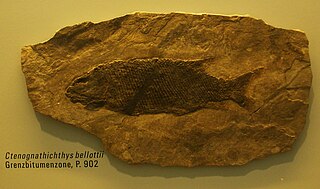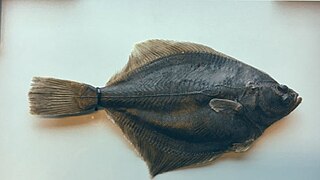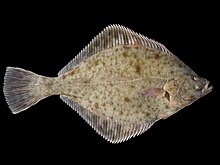
The Baltic Sea is an arm of the Atlantic Ocean that is enclosed by Denmark, Estonia, Finland, Germany, Latvia, Lithuania, Poland, Russia, Sweden, and the North and Central European Plain.

Flounders are a group of flatfish species. They are demersal fish, found at the bottom of oceans around the world; some species will also enter estuaries.

A flatfish is a member of the ray-finned demersal fish order Pleuronectiformes, also called the Heterosomata, sometimes classified as a suborder of Perciformes. In many species, both eyes lie on one side of the head, one or the other migrating through or around the head during development. Some species face their left sides upward, some face their right sides upward, and others face either side upward.

Citharichthys is a genus of flatfish in the large-tooth flounder family, Paralichthyidae. They have both eyes on the left sides of their heads. They are native to the oceans around the Americas, with a single species, C. stampflii off the West African coast. Most are found in relatively shallow depths, but the genus also includes species found in deep water and species that enter fresh water.

Pleuronectidae, also known as righteye flounders, are a family of flounders. They are called "righteye flounders" because most species lie on the sea bottom on their left sides, with both eyes on their right sides. The Paralichthyidae are the opposite, with their eyes on the left side. A small number of species in Pleuronectidae can also have their eyes on the left side, notably the members of the genus Platichthys.

Large-tooth flounders or sand flounders are a family, Paralichthyidae, of flounders. The family contains 14 genera with a total of about 110 species. They lie on the sea bed on their right side; both eyes are always on the left side of the head, while the Pleuronectidae usually have their eyes on the right side of the head.

The starry flounder, also known as the grindstone, emery wheel and long-nosed flounder, is a common flatfish found around the margins of the North Pacific.
Glugea is a genus of microsporidian parasites, predominantly infecting fish. Infections of Glugea cause xenoma formation.

The European flounder is a flatfish of European coastal waters from the White Sea in the north to the Mediterranean and the Black Sea in the south. It has been introduced into the United States and Canada accidentally through transport in ballast water. It is caught and used for human consumption.

Samaridae is a family of crested flounders, small flatfishes native to the Indo-Pacific. The family contains four genera with a total of 29 species.

Ctenognathichthys is an extinct genus of prehistoric bony fish that lived during the Anisian and Ladinian ages of the Middle Triassic epoch in what is now southern/southeastern Switzerland and northern Italy.

Anaethalion is an extinct genus of prehistoric marine and freshwater ray-finned fish related to modern tarpons and ladyfish. It is known from the Late Jurassic to the Early Cretaceous of Europe and northeasterrn Asia, roughly encompassing the Tethys Ocean.

The Pacific sand sole, also known as simply sand sole, is a flatfish species inhabiting the northeastern Pacific waters where it lives on sandy bottoms. The only species in the genus, Psettichthys, it ranges from the Bering Sea to Northern California.

The stone flounder is a flatfish of the family Pleuronectidae. It is a demersal fish that lives on sandy and muddy bottoms in coastal areas at depths of up to 150 metres (500 ft). Its native habitat is the temperate waters of the northwest Pacific, from Japan to the Kuril islands, Sakhalin, Korea, northern China and Taiwan. It is oceanodromous and is found in salt, brackish and fresh waters. It can grow up to 50 centimetres (20 in) in length, and may reach 12 years of age. It is sometimes classfied in the monotypic genus Kareius.

Engyprosopon is a genus of small lefteye flounders. They are found in the Indo-Pacific, ranging from shallow coastal waters to depths in excess of 400 m (1,300 ft).

Samariscus is a genus of crested flounders native to the Indo-Pacific.

Peristedion is a genus of marine ray-finned fish belonging to the family Peristediidae, the armoured gurnards or armored sea robins. These fishes are found in Atlantic and Indo-West Pacific ocean waters.
Tenacibaculum is a Gram-negative and motile bacterial genus from the family of Flavobacteriaceae.
Labilibaculum filiforme is a psychrotolerant, neutrophilic, halotolerant and motil bacterium from the genus of Labilibaculum which has been isolated from sediments from the Baltic Sea.

The Baltic flounder is a species of flatfish endemic to the Baltic Sea, where it is the only known endemic fish species.



















